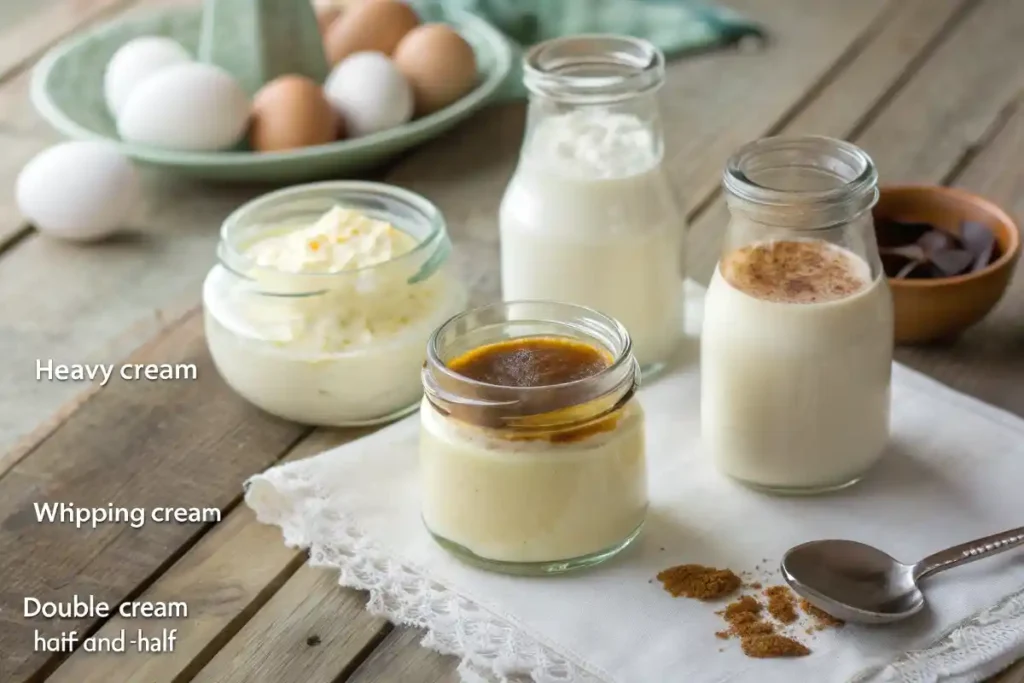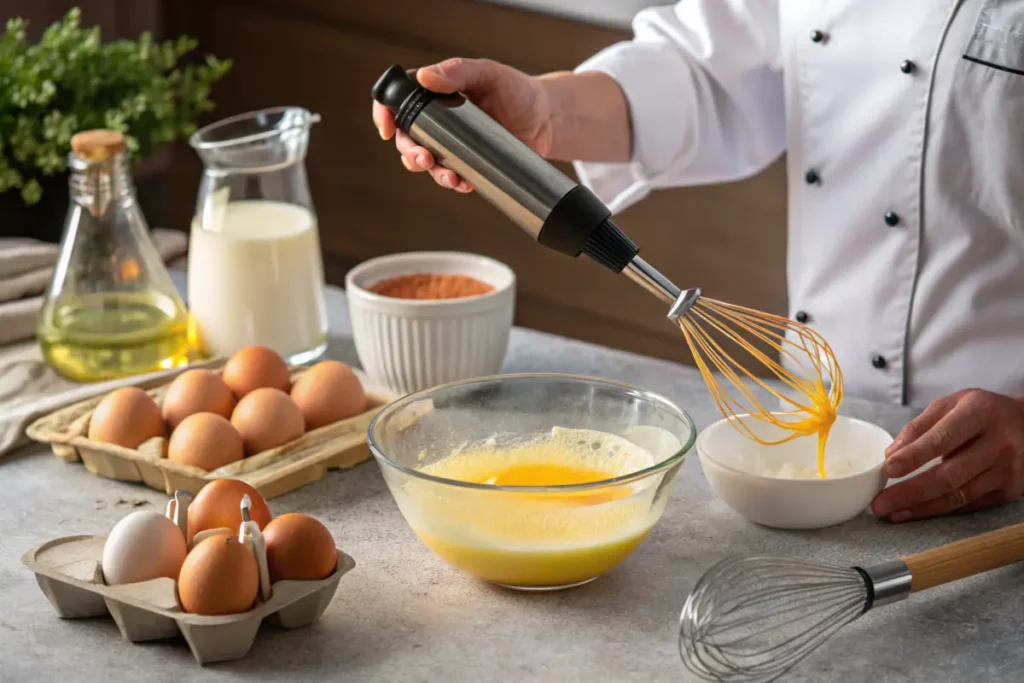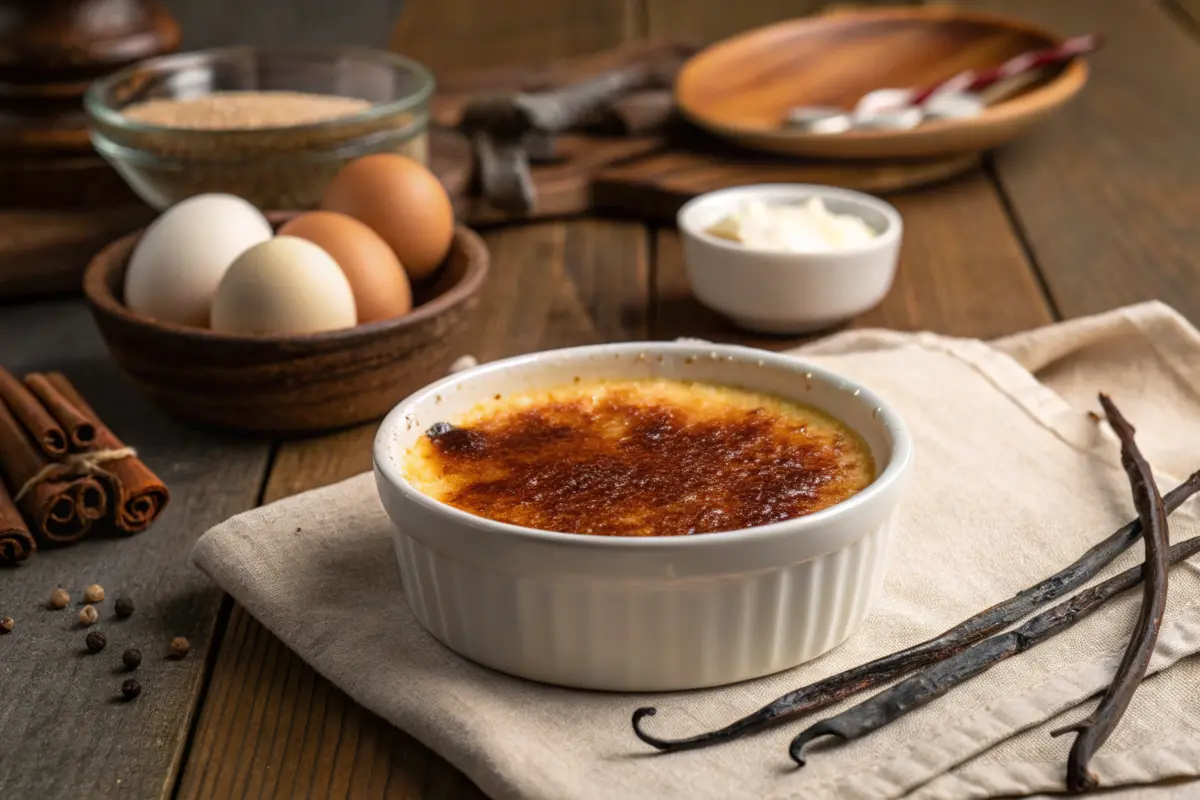Crème brûlée, the luxurious French dessert, is loved for its velvety custard and the satisfying crack of caramelized sugar. While the recipe may seem simple, the secret to achieving perfection lies in choosing the right cream. From ensuring the ideal texture to creating a silky mouthfeel, cream plays a starring role in this classic treat. In this article, we’ll uncover what type of cream is best for crème brûlée, compare different options, and share expert tips to help you make a dessert that’s sure to impress. Let’s dive in, starting with the basics!
Understanding Crème Brûlée
What is Crème Brûlée?
Crème brûlée, meaning “burnt cream” in French, is a celebrated dessert that blends simplicity with elegance. It consists of a smooth, baked custard topped with a brittle layer of caramelized sugar. When done right, the creamy base contrasts beautifully with the crunchy topping, creating an irresistible balance of textures.
Originating in France, this dessert has become a favorite worldwide, gracing menus from fine dining establishments to cozy bistros. The beauty of crème brûlée lies not just in its flavor but also in its adaptability—you can customize it with various flavors like vanilla, citrus, or even chocolate.
Key Components of Crème Brûlée
At its core, crème brûlée is made with four basic ingredients: cream, egg yolks, sugar, and vanilla. Each element serves a unique purpose:
- Cream forms the base, lending richness and smoothness.
- Egg yolks act as a natural thickener, giving the custard its signature texture.
- Sugar sweetens the mix and caramelizes on top for the brûlée effect.
- Vanilla enhances the flavor, adding a warm, aromatic note.
Importance of Cream in Crème Brûlée
The choice of cream can make or break your crème brûlée. Its fat content determines the custard’s texture—too little, and you risk a watery dessert; too much, and it can feel overly heavy. A perfect custard requires just the right balance, ensuring a silky, luxurious mouthfeel. Cream also blends seamlessly with other ingredients, creating a cohesive, indulgent dessert.
Types of Cream for Crème Brûlée

Heavy Cream: The Classic Choice
Heavy cream, also known as double cream in some regions, is the go-to ingredient for crème brûlée. Its high-fat content—typically around 36–40%—ensures a rich, creamy texture that gives the custard its signature smoothness. This type of cream is less likely to curdle during cooking, making it a reliable choice even for beginners.
Not only does heavy cream provide the necessary structure, but it also carries the flavors of vanilla and sugar exceptionally well. If you’re aiming for a traditional crème brûlée, heavy cream is the gold standard.
For more on mastering classic French recipes, check out this guide on crème brûlée techniques.
Whipping Cream: A Lighter Alternative
Whipping cream, with a fat content of 30–36%, is another viable option. While it’s slightly lighter than heavy cream, it still produces a custard that’s rich and satisfying. However, the reduced fat may lead to a slightly less firm set, so you might need to adjust the cooking time to achieve the ideal consistency.
If you prefer a less indulgent version of crème brûlée, whipping cream offers a balanced alternative without sacrificing too much creaminess.
Double Cream: For a Richer Flavor
Double cream takes indulgence to the next level with its exceptionally high-fat content (48–55%). While it’s less common in some parts of the world, it creates a custard that’s incredibly luxurious. However, it’s essential to handle double cream carefully, as its richness can make the dessert feel overly heavy if not balanced with other ingredients.
This cream type is ideal for those who want to elevate their crème brûlée into a decadent treat.
Half-and-Half: A Health-Conscious Option?
Half-and-half, a mixture of cream and milk with around 10–18% fat, might seem like a tempting option for calorie-conscious bakers. While it can technically work, the low fat content often leads to a runnier custard and less velvety texture. If you’re set on using half-and-half, consider adding an extra egg yolk to compensate for the reduced fat.
For a similar lighter dessert, explore alternatives like custards and puddings on this recipe guide.
Factors to Consider When Choosing Cream
Fat Content and Creaminess
The fat content of the cream is the key factor in determining what type of cream is best for crème brûlée. A higher fat percentage translates to a richer, creamier custard, while lower fat levels can result in a texture that’s too thin or watery. Heavy cream strikes the ideal balance, offering both stability and smoothness.
Understanding how fat interacts with egg yolks is crucial. The cream’s fat molecules bind with the yolks during cooking, creating a luscious, cohesive custard. Without enough fat, the mixture can separate or fail to set properly.
Compatibility with Other Ingredients
The type of cream you choose also affects how well it blends with other ingredients. For instance, heavy cream integrates seamlessly with sugar and vanilla, ensuring a uniform flavor profile. If you’re using flavor additives like citrus zest or spices, higher-fat creams are better at absorbing and carrying those flavors.
Availability and Cost
While heavy cream is widely available, some regions may offer alternatives like double cream or whipping cream more readily. Consider availability and cost when choosing your cream. If heavy cream is too pricey, whipping cream can be a practical substitute without sacrificing too much quality.
Tips for Using Cream in Crème Brûlée
How to Temper Cream and Egg Yolks

When making crème brûlée, tempering the cream and egg yolks is a must to avoid curdling. Start by warming the cream over low heat until it’s just steaming, not boiling. Then, slowly whisk a small amount of the warm cream into the egg yolks. This step gently raises the temperature of the yolks without cooking them. Once combined, gradually pour the rest of the cream into the mixture while whisking continuously.
Tempering creates a smooth custard base and is a crucial step when working with any type of cream. Whether you use heavy cream, whipping cream, or an alternative, proper tempering ensures the best results for your crème brûlée.
Achieving the Perfect Consistency
The cream you choose significantly impacts the consistency of your dessert. Heavy cream generally provides the best results, creating a rich, silky custard that sets firmly but still jiggles slightly in the center. Baking in a water bath also helps regulate the heat, preventing the custard from overcooking or cracking.
Once baked, allow the custard to cool at room temperature before refrigerating for at least 4 hours. This helps the custard firm up while maintaining its velvety texture.
Using Substitutes or Mixes
If heavy cream isn’t an option, you can experiment with substitutes like coconut cream for a dairy-free version. Be cautious, though—substitutes may alter the flavor and texture. If using a mix of cream and milk, consider increasing the egg yolks to maintain richness.
For more techniques on creating silky custards, visit this crème brûlée preparation guide.
Common Mistakes and How to Avoid Them
Overbaking or Undercooking the Custard
One of the most common pitfalls in making crème brûlée is improper baking. Overbaking causes the custard to become stiff and grainy, while underbaking results in a runny texture. To achieve the perfect set, bake the custard until the edges are firm but the center still jiggles slightly when shaken.
Using a thermometer can help. The internal temperature of the custard should reach around 170°F (77°C). Also, remember to use a water bath—it ensures even cooking and adds moisture to the oven environment.
Improper Caramelization of Sugar
Caramelizing the sugar topping can be tricky. Use fine sugar for a quick, even melt. A kitchen blowtorch is ideal, allowing you to control the caramelization process without overheating the custard. If you don’t have a blowtorch, the broiler works too, but watch closely to avoid burning the sugar or softening the custard.
Using the Wrong Type of Cream
Choosing the wrong cream can lead to disappointing results. Low-fat options like half-and-half often lack the richness needed for the custard to set properly. Stick to heavy cream for the best texture and flavor.
FAQs About Cream for Crème Brûlée (290 Words)
What Is the Best Cream for Beginners?
For beginners, heavy cream is the best option for crème brûlée. Its high-fat content provides the rich, smooth texture that this dessert is famous for, and it’s forgiving if you make slight errors during the cooking process. Heavy cream also blends effortlessly with other ingredients, ensuring consistent results.
Can I Use Non-Dairy Alternatives?
Yes, non-dairy options like coconut cream can be used, but they will alter the flavor and texture of the dessert. Coconut cream, for instance, adds a tropical note that may complement or overwhelm the dish, depending on your preference. For a non-dairy alternative that stays closer to the classic taste, consider oat cream or cashew cream.
Why Did My Custard Not Set?
If your custard didn’t set, it’s likely due to using a cream with insufficient fat content. This is why heavy cream is often recommended as the best cream for crème brûlée. Additionally, underbaking or skipping the water bath can also lead to a runny custard.
Can I Use Regular Milk Instead of Cream?
While regular milk might seem like a cost-effective option, it lacks the fat needed for the custard to achieve the desired velvety texture. If you must use milk, try mixing it with a small amount of cream to balance the fat content.
LSI Keywords and Conclusion
Using LSI Keywords to Enhance Your Recipe
When discussing what type of cream is best for crème brûlée, integrating related terms like “silky texture,” “custard consistency,” and “rich dessert” not only improves clarity but also helps readers understand the nuances of this classic dish. Additionally, incorporating terms such as “baking techniques,” “tempering eggs,” and “water bath” provides practical guidance for achieving perfection.
Summing Up the Best Practices for Choosing Cream
Choosing the right cream is the cornerstone of a flawless crème brûlée. Heavy cream is the gold standard, offering the fat content and creamy texture needed for a rich, indulgent custard. Whipping cream and double cream are great alternatives, while half-and-half works best for lighter variations. Non-dairy options like coconut cream can cater to specific dietary needs but may change the dessert’s flavor profile.
Exploring Flavor Variations with Cream

Enhancing Crème Brûlée with Flavored Creams
Once you’ve mastered the classic version, experimenting with flavored creams is an exciting way to elevate your crème brûlée. Infusing heavy cream with ingredients like vanilla beans, citrus zest, or spices such as cinnamon and nutmeg adds layers of complexity. Vanilla bean, in particular, is a popular choice because it enhances the custard’s natural sweetness without overpowering it.
To infuse your cream, gently heat it with your chosen flavoring and let it steep for 10–15 minutes before straining. This step ensures the infused flavor is smooth and evenly distributed in your custard.
Using Alternative Creams for Unique Twists
If you’re feeling adventurous, try substituting heavy cream with unique alternatives for a new twist. For example, coconut cream not only caters to dairy-free diets but also introduces a tropical flair. Similarly, almond cream offers a nutty undertone that pairs beautifully with caramelized sugar. Keep in mind that these alternatives may slightly alter the texture, so proper tempering and baking techniques are essential.
Understanding what type of cream is best for crème brûlée will guide you in creating both classic and innovative versions of this iconic dessert.
Final Thoughts and Recipe Inspiration
The Cream Choice Makes All the Difference
The cream you choose plays a defining role in the texture and flavor of crème brûlée. Heavy cream remains the ultimate choice for most recipes, offering the perfect balance of richness and stability. However, options like whipping cream or even non-dairy substitutes can work depending on your preferences and dietary needs.
Understanding what type of cream is best for crème brûlée empowers you to make informed decisions when crafting this dessert. Whether you stick to tradition or venture into creative variations, the key lies in balancing fat content, flavor, and technique.
Ready to Get Cooking?
Now that you know how to select the ideal cream, it’s time to put your knowledge to the test. Experiment with different types, infusions, and techniques to make a crème brûlée that suits your taste. For even more inspiration, explore dessert recipes that complement your culinary creativity. For unique crème brûlée variations, check out the best custard recipes on our site.
No matter the cream you choose, your crème brûlée journey promises to be a rewarding and delicious adventure!

